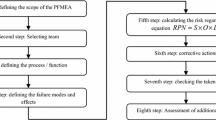Abstract
Dependability is a key decision factor in today’s global business environment affecting product cost and process. Dependability reflects user confidence in fitness for use by attaining satisfaction in product performance capability, delivery, service availability upon demand, and minimizing cost. The main objective of this study is to develop an integrated approach for evaluation of manufacturing systems based on dependability indicators for conducting a better dependability management system (DMS) through integration of the principal component analysis (PCA) and the data envelopment analysis (DEA). To achieve the objective of this study, an industrial sector—chemicals and chemical products in Iran—is selected as the case of this study in accordance with the International Standard for Industrial Classification of all economic activities (ISIC). Firstly, we define dependability indicators, for both inputs and outputs, based on IEC 60300. Due to the extra amount of indicators, we utilize a hierarchical structure to cluster the indicators for an easier analysis. Secondly, for reducing the number of some variables, we apply pair-wise comparison to assign weights and to unify the related sub-criteria to one main criterion. Finally, an integrated DEA–PCA approach is employed to assess the most and the least dependable units and to find critical indicators in macro and micro levels in order to make policy for implementation of DMS in manufacturing systems.
Similar content being viewed by others
References
Kostic SB, Arandjelovic V Dj (1995) Dependability, a key factor to the quality of products IEC 300 series and ISO 9000 series standards. Int J Qual Reliab Manage 12:36–43 doi:10.1108/02656719510093547
Laprie JC, Costes A (1982) Dependability: A unifying concept for reliable computing, Proc. 12th 1EEE International Symposium on Fault-Tolerant Computing(FTCS-12), June: 18–21
IEC 60300-1 Dependability Management—Dependability Management Systems(2003) International Electrotechnical Commission, Geneva
IEC 60300-2 Dependability Management—Guidance for Dependability Programme Management (2003) International Electrotechnical Commission, Geneva
Saaty TL (1980) The analytic hierarchy process. McGraw-Hill, New York, NY
Charnes A, Cooper WW, Rhodes E (1978) Measuring the efficiency of decision making units. Eur J OR 2:429–444 doi:10.1016/0377-2217(78)90138-8
Zhu J (2003) Quantitative models for Performance Evaluation and Benchmarking. Kluwer, Boston
Jolliffe IT (2002) Principal component analysis. Springer, New York
Sinuany-Stern Z, Mehrez A, Hadad Y (2000) An AHP/DEA methodology for ranking decision making units. Int Trans OR 7:109–124 doi:10.1111/j.1475-3995.2000.tb00189.x
Korpela J, Lehmusvaara A, Nisonenc J (2007) Warehouse operator selection by combining AHP and DEA methodologies. Int J Production Economics 108:135–142
Azadeh A, Ebrahimipour V (2004) An integrated approach for assessment and ranking of manufacturing systems based on machine performance. Int J IE Theory Appl Pract 11:349–363
Azadeh A, Ghaderi SF, Partovi Miran Y, Ebrahimipour V, Suzuki K (2007) An integrated framework for continuous assessment and improvement of manufacturing systems. Appl Math Comput 186:1216–1233 doi:10.1016/j.amc.2006.07.152
Azadeh A, Ebrahimipour V (2007) An integrated PCA DEA framework for assessment and ranking of manufacturing systems based on equipment performance. Eng Computations: Int J for C A Engineering and Software 24:347–372
Zhu J (1998) Data envelopment analysis vs. Principal component analysis: an illustrative study of economic performance of Chinese cities. Eur J OR 111(1):50–61 doi:10.1016/S0377-2217(97)00321-4
Adler N, Golany B (2001) Evaluation of deregulated airline networks using data envelopment analysis combined with principal component analysis with an application to Western Europe. Eur J OR 132:260–273 doi:10.1016/S0377-2217(00)00150-8
Adler N, Berechman J (2001) Measuring airport quality from the airlines view point: an application of data envelopment analysis. Transp Policy 8:171–181 doi:10.1016/S0967-070X(01)00011-7
Shanmugam R, Johnson C (2007) At a crossroad of data envelopment and principal component analyses. Omega 35:351–364 doi:10.1016/j.omega.2005.07.005
Banker RD, Charnes A, Cooper WW (1984) Some models for estimating technical and scale inefficiencies in DEA. Manage Sci 32:1078–1092
Premachandra IM (2001) A note on DEA vs. principal component analysis: an improvement to Joe Zhu’s approach. Eur J OR 132:553–560 doi:10.1016/S0377-2217(00)00145-4
Anderson P, Peterson NC (1993) A procedure for ranking efficient units in data envelopment analysis. Manage Sci 139:1261–1294
Sarbu C, Pop HF (2005) Principal component analysis versus fuzzy principal component analysis. A case study: the quality of Danube water (1985–1996). Talanta 65:1215–1220 doi:10.1016/j.talanta.2004.08.047
Zavatto DM, Gibson J Talbot M (1998) Portable advanced diagnostic system. AUTOTESTCON Proceedings, Salt Lake City, USA: 536–41
Soderholm P (2007) Review. A system view of the No Fault Found (NFF) phenomenon. Reliab Eng Syst Saf 92:1–14 doi:10.1016/j.ress.2005.11.004
Kostic SB, Pendic Z, Arandjelovic V Dj (1992). The concept of computer-based systems with embedded logistic support, Proceedings of 8th International Logistics Symposium of Society of Logistics Engineering (SOLE), Madrid. April
Ebrahimipour V, Suzuki K (2006) A synergetic approach for assessing and improving equipment performance in offshore industry based on dependability. Reliab Eng Syst Saf 9:110–119
Wanga L, Chua J, Wub J (2007) Selection of optimum maintenance strategies based on a fuzzy analytic hierarchy process. Int J Prod Econ 107:151–163 doi:10.1016/j.ijpe.2006.08.005
Williams R, Banner J, Knowles I, Dube M, Natishan M, Pecht M (1998) An investigation of cannot duplicate failures. Qual Reliab Eng Int 14(5):331–337 doi:10.1002/(SICI)1099-1638(199809/10)14:5<331::AID-QRE183>3.0.CO;2-L
International Year Book of Industrial Statistics, 2003.
Trall RM (1996) Duality, classifications and slacks in DEA. Ann Oper Res 66:109–138 doi:10.1007/BF02187297
Cooper WW, Seiford LM, Tone K (2000) Data envelopment analysis. Kluwer, Boston
Author information
Authors and Affiliations
Corresponding author
Rights and permissions
About this article
Cite this article
Rezaie, K., Dehghanbaghi, M. & Ebrahimipour, V. Performance evaluation of manufacturing systems based on dependability management indicators—case study: chemical industry. Int J Adv Manuf Technol 43, 608–619 (2009). https://doi.org/10.1007/s00170-008-1726-8
Received:
Accepted:
Published:
Issue Date:
DOI: https://doi.org/10.1007/s00170-008-1726-8




